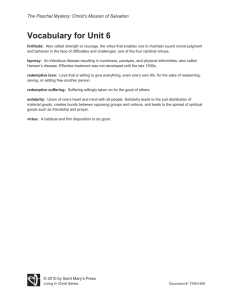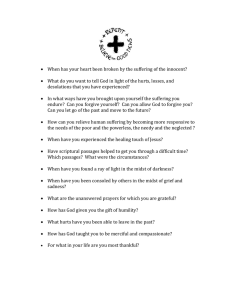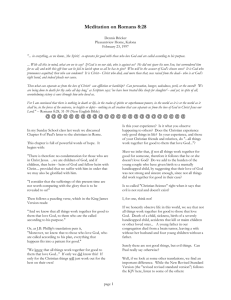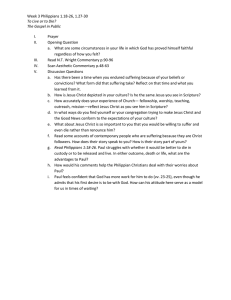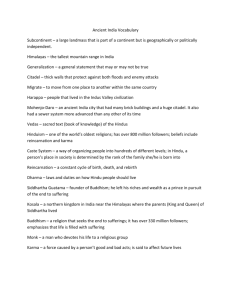DISCUSSION Forum #1: Christian Cosmology September 6, 2013
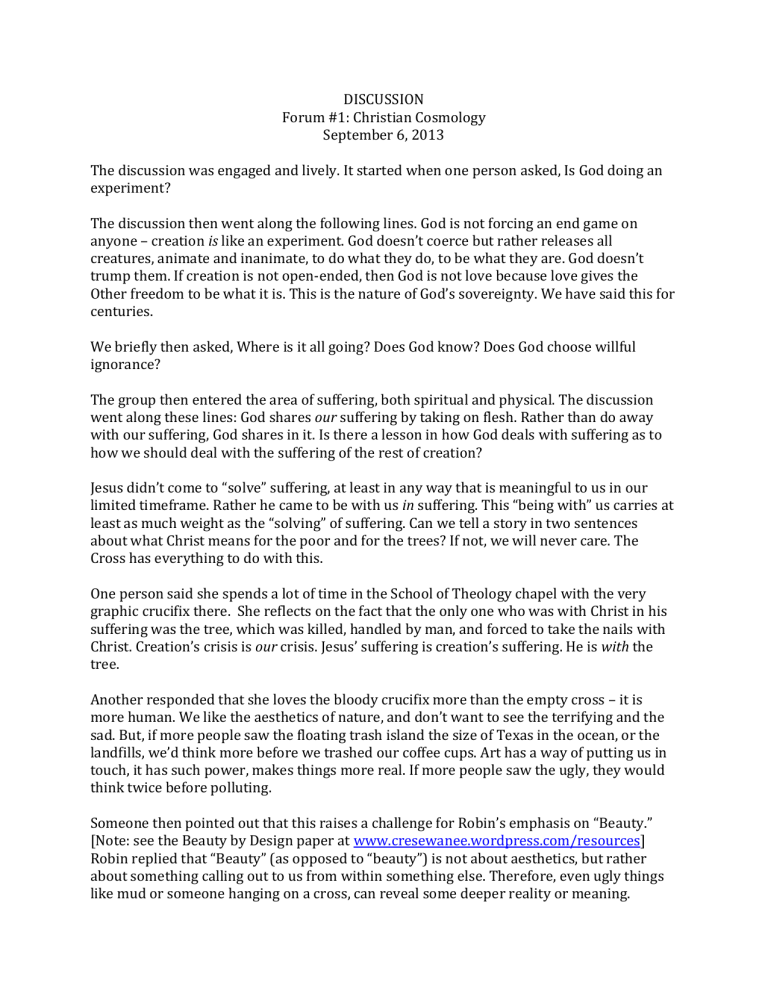
DISCUSSION
Forum #1: Christian Cosmology
September 6, 2013
The discussion was engaged and lively. It started when one person asked, Is God doing an experiment?
The discussion then went along the following lines. God is not forcing an end game on anyone – creation is like an experiment. God doesn’t coerce but rather releases all creatures, animate and inanimate, to do what they do, to be what they are. God doesn’t trump them. If creation is not open-ended, then God is not love because love gives the
Other freedom to be what it is. This is the nature of God’s sovereignty. We have said this for centuries.
We briefly then asked, Where is it all going? Does God know? Does God choose willful ignorance?
The group then entered the area of suffering, both spiritual and physical. The discussion went along these lines: God shares our suffering by taking on flesh. Rather than do away with our suffering, God shares in it. Is there a lesson in how God deals with suffering as to how we should deal with the suffering of the rest of creation?
Jesus didn’t come to “solve” suffering, at least in any way that is meaningful to us in our limited timeframe. Rather he came to be with us in suffering. This “being with” us carries at least as much weight as the “solving” of suffering. Can we tell a story in two sentences about what Christ means for the poor and for the trees? If not, we will never care. The
Cross has everything to do with this.
One person said she spends a lot of time in the School of Theology chapel with the very graphic crucifix there. She reflects on the fact that the only one who was with Christ in his suffering was the tree, which was killed, handled by man, and forced to take the nails with
Christ. Creation’s crisis is our crisis. Jesus’ suffering is creation’s suffering. He is with the tree.
Another responded that she loves the bloody crucifix more than the empty cross – it is more human. We like the aesthetics of nature, and don’t want to see the terrifying and the sad. But, if more people saw the floating trash island the size of Texas in the ocean, or the landfills, we’d think more before we trashed our coffee cups. Art has a way of putting us in touch, it has such power, makes things more real. If more people saw the ugly, they would think twice before polluting.
Someone then pointed out that this raises a challenge for Robin’s emphasis on “Beauty.”
[Note: see the Beauty by Design paper at www.cresewanee.wordpress.com/resources ]
Robin replied that “Beauty” (as opposed to “beauty”) is not about aesthetics, but rather about something calling out to us from within something else. Therefore, even ugly things like mud or someone hanging on a cross, can reveal some deeper reality or meaning.
Beauty and grief over degraded people and mountains go together. If we don’t experience
Beauty in something, how can we fully experience grief when it is degraded, causing us to repent? The existence of strip malls, slums, islands of trash, and degraded mountains speaks reams about the gospel we preach daily by our lives. What is our human-impacted world saying to us? There should be great repentance and grief about this. Once we help people experience the Beauty in a place, they will find it much more difficult to degrade it.
This then motivates us to find another way to do things.
Responses: This would be powerful. Pure science, rationality, objectivity can’t access the heart. The monastic tradition talks about the Book of Scripture, the Book of Nature, and the
Book of the Heart. We need the heart. Some scientists like Einstein have found it in what they do and speak about it.
In response to a question as to whether the cosmology Robin proposed sounds scary to others, one participant said he cannot operate as an educator without hope to offer those we are bringing along, particularly in the face of the evidence of the graph of the rising CO
2 concentration in the atmosphere. Our students need hope to carry on in the face of the reality check of frightening evidence. We need hope for the people and the planet. As educators we need to help students encounter the Beauty in other people and nature, and in the chilling graph. We need to hear what the graph is speaking to us –telling us how we’re failing as an experiment if we don’t have the sense to talk to each other, and asking us why we can’t manipulate our experiment in some way to change the outcome. We are afraid to change how we do things. We need hope to do so.
A young participant stated that a lot of the young do see something is wrong. But in this person’s southern diocese most of the people, including the church leadership, isn’t addressing the issue, and this is very frustrating to him. How do we get the world he comes from to acknowledge what’s going on?
The question then arose, Why is it that we don’t hear this cosmology and its implications talked about in church on Sunday? Is it because it’s too scary? Answer: perhaps it’s because in our culture if we “don’t like the channel, we turn it off.” For a lot of parishes if they don’t like what the priest is saying, they just go to another church.
So, is this a case of massive protective self-denial for fear of losing hope? Our faith says that
God is about redeeming the seemingly unredeemable. This problem is something our faith can address: a sense of hope.
In the past we didn’t want to address slavery and injustice because we thought it wasn’t part of our faith. But the scriptures do address these things. We woke up at some point and were amazed at how they actually did address these concerns. The same is true of the environment. The scriptures are full of environmental concern, and they offer great hope.
The Incarnation and Resurrection should give us great hope that God is up to something, although we’re not sure exactly what. God is “with us” in all this. Melting ice caps are a concern for God. If not, “oh my God…!”
To effect change we have to see that our core doctrines address these issues. The problem is that we see Christ’s coming and his death and resurrection in anthropomorphic terms. A participant said he likes our linking the creation with Christ. Why did Christ save us? Was it just for people? Until we answer this question doctrinally we don’t bring about change.
Along these lines Larry Rasmussen said that the cosmology we live out does not correspond with our story of salvation. Until those two align, we are in real trouble. But when we get the two aligned, we have a big solution.
The discussion ended with Robin saying that next week Sid will be presenting a Buddhist cosmology and its implications. We need to be thinking about what we as a group of religious interfaith people and as members of our own traditions are going to want to say to others. Accordingly we need to write a document that does this, even if we don’t agree on all points. This goal will help us focus our thoughts. So, will we want a third session to hash all this out? Let’s talk about this at the end of our next session.
